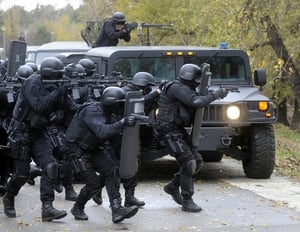 The FBI recently reported that there were 30 active shooter incidents in the U.S. in 2017, up from 20 in 2016. These FBI statistics show that there's an upward trend in the number of incidents each year, with 2018 being no exception. Because the number and severity of these incidents are increasing, it's imperative you consider what to do if faced with an active shooter incident.
The FBI recently reported that there were 30 active shooter incidents in the U.S. in 2017, up from 20 in 2016. These FBI statistics show that there's an upward trend in the number of incidents each year, with 2018 being no exception. Because the number and severity of these incidents are increasing, it's imperative you consider what to do if faced with an active shooter incident.
What You Need to Know About Active Shooters
Active shooters usually plan their attacks carefully, and in many instances, they're motivated by a grievance against a specific group of people, an organization, or the government. Victims may be targeted or randomly selected. Active shooters often have no history of mental illness or any criminal record, but indicators include an increased use of alcohol and drugs, absenteeism, workplace disobedience, anger, paranoia, mood swings and interest in previous violent incidents and weapons.
The duration of an active shooter incident is short; they are often over within 15 minutes, and in most cases, the active shooter does not expect to live.
How to Respond When There's an Active Shooter in Your Vicinity
Mass shooting incidents occur in businesses, schools and government facilities, so it's essential organizations prepare for that eventuality. The US Department of Homeland Security (DHS) recommends the following for persons caught in an active shooter situation:
1. Leave the area - If an active shooter attack takes place, the first step is to try to escape from the area immediately, helping and encouraging others to join you.
2. Hide - If it isn't possible to flee, find a hiding place that's out of view. If feasible, lock yourself in, and barricade the door as protection and to prevent the shooter from entering. Keep away from windows and hide behind something substantial. Be quiet, switch your phone to silent and if you can, dial 911.
3. Actively Confront - Never confront the shooter unless you have no alternative. Always try to flee or hide if you can. However, if you are in the presence of the shooter and there is no option to flee or hide, the DHS recommends trying to incapacitate or distract the shooter by acting as aggressively as you can. Shout, yell, throw items and fully commit to your action to save your life and those of others around you. If nothing else, it will distract the shooter who may flee. This is a better course of action than remaining passive and being an easy target.
What to Do When Law Enforcement Officers Arrive or Are Present
These DHS recommendations continue to note that the first law enforcement officers to arrive will directly proceed to the last known location of shots fired and try to neutralize the shooter. As they will be armed, exercise caution and immediately follow any instructions. Stay calm, keep your hands visible by raising them above your head so officers know you're no threat. Don't scream or rush towards the officers, but quickly and quietly follow the route officers used to enter the building or area.
Preparation
Here are some things that should be done to prepare for the possibility of an active shooter incident.
- Develop an emergency action plan
- Identify escape routes
- Know who to contact
- Have this information printed, distributed and placed on notice boards
- If practical, conduct mock exercises in conjunction with local law enforcement
Graham Medical manufactures products for first responders, including emergency transport stretchers for evacuating victims. Thanks to our close association with EMS and other first responders, we are uncomfortably aware of the increase in active shooter incidents and believe its important to share this information with the public. Subscribe to our blog for more information.

